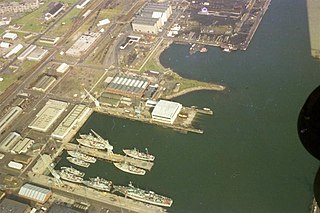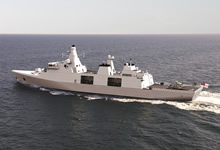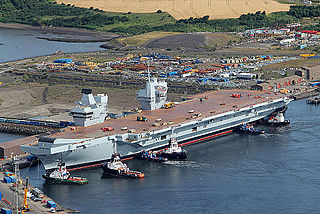Related Research Articles

The Resolution class was a class of four nuclear ballistic missile submarines (SSBN) built for the Royal Navy as part of the UK Polaris programme. Each submarine was armed with up to 16 UGM-27 Polaris A-3 nuclear missiles.
Halliburton Company is an American multinational corporation responsible for most of the world's hydraulic fracturing operations. In 2009, it was the world's second largest oil field service company. It has operations in more than 70 countries. It owns hundreds of subsidiaries, affiliates, branches, brands, and divisions worldwide and employs approximately 55,000 people. The company has dual headquarters located in Houston and in Dubai, and remains incorporated in the United States.

KBR, Inc. is a U.S. based company operating in fields of science, technology and engineering. KBR works in various markets including aerospace, defense, industrial and intelligence. After Halliburton acquired Dresser Industries in 1998, Dresser's engineering subsidiary, the M. W. Kellogg Co., was merged with Halliburton's construction subsidiary, Brown & Root, to form Kellogg Brown & Root. KBR and its predecessors have received many contracts with the U.S. military including during World War II, the Vietnam War, and the Iraq War. Democratic Congressman Lyndon B. Johnson, later President of the United States, was instrumental in providing government contracts for Brown & Root, in exchange for the company funding his campaigns and otherwise providing money to him.

Rosyth is a town on the Firth of Forth, three miles (4.8 km) south of the centre of Dunfermline. According to the census of 2011, the town has a population of 13,440.

The seventh HMS Dreadnought was the United Kingdom's first nuclear-powered submarine, built by Vickers Armstrongs at Barrow-in-Furness. Launched by Queen Elizabeth II on Trafalgar Day 1960 and commissioned into service with the Royal Navy in April 1963, she continued in service until 1980. The submarine was powered by a S5W reactor, a design made available as a direct result of the 1958 US–UK Mutual Defence Agreement.

Vickers Shipbuilding and Engineering, Ltd (VSEL) was a shipbuilding company based at Barrow-in-Furness, Cumbria in northwest England that built warships, civilian ships, submarines and armaments. The company was historically the Naval Construction Works of Vickers Armstrongs and has a heritage of building large naval warships and armaments. Through a complicated history the company's shipbuilding division is now BAE Systems Submarine Solutions and the armaments division is now part of BAE Systems Land & Armaments.
The fifth HMS Sceptre is a Swiftsure-class submarine built by Vickers in Barrow-in-Furness. She was launched in 1976, with a bottle of cider against her hull. She was commissioned on 14 February 1978, by Lady Audrey White. She was the tenth nuclear fleet submarine to enter service with the Royal Navy. She was decommissioned on 10 December 2010, at which time she was the oldest commissioned vessel in the Royal Navy still available for service; in total around 1,500 men served aboard during her commission. In theory, she is replaced by the first Astute-class submarine in service, HMS Astute.
British Shipbuilders (BS) was a public corporation that owned and managed the shipbuilding industry in Great Britain from 1977 through the 1980s. Its head office was at Benton House in Newcastle upon Tyne, England.

The Commander-in-Chief Fleet (CINCFLEET) was the admiral responsible for the operations of the ships, submarines and aircraft of the British Royal Navy from 1971 until April 2012. The post was subordinate to the First Sea Lord, the professional head of the Naval Service. In its last years, as the Navy shrank, more administrative responsibilities were added.

Rosyth Dockyard is a large naval dockyard on the Firth of Forth at Rosyth, Fife, Scotland, owned by Babcock Marine, which formerly undertook refitting of Royal Navy surface vessels and submarines. Before its privatisation in the 1990s it was formerly the Royal Naval Dockyard Rosyth. Its primary role now is the dismantling of decommissioned nuclear submarines. It is also the integration site for the Royal Navy's newest aircraft carriers, the Queen Elizabeth class as well as the Type 31 Frigate.

The Cockatoo Island Dockyard was a major dockyard in Sydney, Australia, based on Cockatoo Island. The dockyard was established in 1857 to maintain Royal Navy warships. It later built and repaired military and battle ships, and played a key role in sustaining the Royal Australian Navy. The dockyard was closed in 1991, and its remnants are heritage listed as the Cockatoo Island Industrial Conservation Area.

Babcock International Group plc is a British aerospace, defence and nuclear engineering services company based in London, England. It specialises in managing complex assets and infrastructure. Although the company has civil contracts, its main business is with public bodies, particularly the United Kingdom's Ministry of Defence and Network Rail. The company has four operating sectors, with overseas operations based in Africa, North America, South America, Europe and Australia.
Eurest Support Services (ESS) is a subsidiary of the catering company Compass Group PLC specializing in harsh-environment large-scale food service and facilities management. Its primary clients are military forces and other security services, major defense contractors, and construction, mining, and oil exploration and production facilities worldwide.
Appledore Shipbuilders is a shipbuilder in Appledore, North Devon, England.

MT Deerhound is a Dog-class medium berthing tugboat built for the Royal Maritime Auxiliary Service (RMAS) in 1966 by Appledore Shipbuilders, Appledore, North Devon.

Her Majesty's Naval Base, Devonport is one of three operating bases in the United Kingdom for the Royal Navy and is the sole nuclear repair and refuelling facility for the Royal Navy. The largest naval base in Western Europe, HMNB Devonport is located in Devonport, in the west of the city of Plymouth, England.
BAE Systems Maritime – Naval Ships is a wholly owned subsidiary company of BAE Systems, specialising in naval surface shipbuilding and combat systems integration. One of three divisions of BAE Systems Maritime, along with BAE Systems Submarines and BAE Systems Maritime – Maritime Services, it is the largest shipbuilding company in the United Kingdom, one of the largest shipbuilders in Europe, and one of the world's largest builders of complex warships.

The Type 31 frigate or Inspiration class, and formerly known as the Type 31e frigate or General Purpose Frigate (GPF), is a planned class of frigate intended to enter service with the United Kingdom's Royal Navy in the 2020s alongside the submarine-hunting Type 26 frigate. Designed by Babcock International, it is also marketed under the name Arrowhead 140 and was based on the hull of the Iver Huitfeldt-class frigate.

The Aircraft Carrier Alliance is a partnership of BAE Systems, Babcock International, Thales Group and the Ministry of Defence, together with Rosyth Dockyard, to build the Queen Elizabeth-class aircraft carriers for the Royal Navy. Along with Rosyth and BAE Systems' Govan yard, four other shipyards involved in the build process are A&P Tyne, Appledore Shipbuilders, Cammell Laird and HMNB Portsmouth.
Ministry of Defence Caledonia is a military establishment of the Ministry of Defence based at the former Royal Naval Dockyard, Rosyth in Scotland.
References
- ↑ HMNB Devonport : Naval Bases & Air Stations : Establishments : Operations and Support : Royal Navy Archived 2007-06-10 at the Wayback Machine
- ↑ Devonport Management Limited
- ↑ Buchan, David (30 August 1986). "Three Bid For RN Dockyard". Financial Times . Financial Times. p. 3.
- ↑ "Devonport under commercial management". PR Newswire . Origin Universal News Services. 6 April 1987.
- 1 2 White, David (25 June 1993). "Shrinking navy prompted great nuclear race: David White tracks the two-year highly politicised battle for the contract to refit Trident submarines". Financial Times. Financial Times. p. 8.
- ↑ "Anglo-American consortium buys Devonport Royal Naval Dockyard for pounds 40m". The Independent . Newspaper Publishing. 12 February 1997. p. 17. Retrieved 19 January 2007.
- ↑ Foley, Stephen (28 January 2007). "BAE finds clear blue water in bid to win Devonport yard". Independent on Sunday. Independent News and Media. Retrieved 28 January 2007.
- ↑ Naval dockyard bought for £350m BBC News 10 May 2007